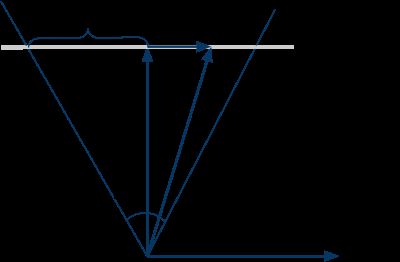这个结论在求交的时候会用到。
有两个私有成员,原点和方向,数学上可用参数函数来表示:r(t)=o+td;t>=0cray.h
#ifndef CRAY_H #define CRAY_H #include #include "gvector3.h" #define PI 3.14159 using namespace std; class CRay { private: GVector3 origin; GVector3 direction; public: CRay(); CRay(GVector3 o,GVector3 d); ~CRay(); void setOrigin(GVector3 o); void setDirection(GVector3 d); GVector3 getOrigin(); GVector3 getDirection(); //通过向射线的参数方程传入参数t而获得在射线上的点 GVector3 getPoint(double t); }; #endif
cray.cpp
#include "cray.h" CRay::CRay() { } CRay::~CRay() { } CRay::CRay(GVector3 o,GVector3 d) { origin=o; direction=d; } void CRay::setDirection(GVector3 d) { direction=d; } void CRay::setOrigin(GVector3 o) { origin=o; } GVector3 CRay::getDirection() { return direction; } GVector3 CRay::getOrigin() { return origin; } GVector3 CRay::getPoint(double t) { return origin+direction*t; }
初试画板
这里用GLFW作为opengl的编程框架。
GLFW是一个自由,开源,多平台的图形库,可用于创建窗口,渲染OpenGL,管理输入。
GLFW的配置见《 GLFW入门学习》.这里主要要做的就是将我们窗口映射成像素的点阵,然后填充颜色。
#include #include #include #define WINDOW_WIDTH 600 #define WINDOW_HEIGHT 600 void initScene(int w,int h) { // 启用阴影平滑 glShadeModel( GL_SMOOTH ); // 黑色背景 glClearColor( 0.0, 0.0, 0.0, 0.0 ); // 设置深度缓存 glClearDepth( 1.0 ); // 启用深度测试 glEnable( GL_DEPTH_TEST ); // 所作深度测试的类型 glDepthFunc( GL_LEQUAL ); // 告诉系统对透视进行修正 glHint( GL_PERSPECTIVE_CORRECTION_HINT, GL_NICEST ); } //这里进行所有的绘图工作 void drawScene() { float colorSpan=0.0005f; float color=0.0f; float pixelSize=2.0f; float posY=-1.0f; float posX=-1.0f; long maxDepth=20; glClear(GL_COLOR_BUFFER_BIT | GL_DEPTH_BUFFER_BIT); glLoadIdentity(); //将原点移动到左下角 glTranslatef(-0.5f,-0.5f,-1.0f); glPointSize(2.0); glBegin(GL_POINTS); double dx=1.0f/WINDOW_WIDTH; double dy=1.0f/WINDOW_HEIGHT; float dD=255.0f/maxDepth; glBegin(GL_POINTS); for (long y = 0; y < WINDOW_HEIGHT; ++y) { double sy = 1-dy*y; for (long x = 0; x < WINDOW_WIDTH; ++x) { double sx =dx*x; float colorR=x*1.0/WINDOW_WIDTH*255; float colorB=y*1.0/WINDOW_HEIGHT*255; glColor3ub(colorR,0,colorB); glVertex2f(sx,sy); } } // 交换缓冲区 glfwSwapBuffers(); } //重置窗口大小后的回调函数 void GLFWCALL resizeGL(int width, int height ) { // 防止窗口大小变为0 if ( height == 0 ) { height = 1; } // 重置当前的视口 glViewport( 0, 0, (GLint)width, (GLint)height ); // 选择投影矩阵 glMatrixMode( GL_PROJECTION ); // 重置投影矩阵 glLoadIdentity(); // 设置视口的大小 gluPerspective( 45.0, (GLfloat)width/(GLfloat)height, 0.1, 100.0 ); // 选择模型观察矩阵 glMatrixMode( GL_MODELVIEW ); glLoadIdentity(); } int main( void ) { //记录程序运行状态 int running = GL_TRUE; //初始化 GLFW if( !glfwInit() ) { exit( EXIT_FAILURE ); } // 创建一个OpenGL 窗口 if( !glfwOpenWindow( WINDOW_WIDTH,WINDOW_HEIGHT,6,6,6,0,32,0,GLFW_WINDOW) ) { glfwTerminate(); exit( EXIT_FAILURE ); } //初始化OpenGL窗口 initScene(WINDOW_WIDTH, WINDOW_HEIGHT); //设置窗口大小发生变化时的回调函数 glfwSetWindowSizeCallback(resizeGL); //主循环 while( running ) { // OpenGL rendering goes here... glClear( GL_COLOR_BUFFER_BIT ); // 当按下ESC键的时候触发 running = !glfwGetKey( GLFW_KEY_ESC ) &&glfwGetWindowParam( GLFW_OPENED ); drawScene(); //延时0.05秒 glfwSleep(0.05 ); } glfwTerminate(); //退出程序 exit( EXIT_SUCCESS ); }
渲染结果:

球体
球面的几何定义是到空间某点距离一定的点的集合。
这里着重需要说明的是球体的isIntersected函数,用于求光线是否与球体相交,并将结果存在result中返回。
中心点为c、半径为r的球体表面可用等式(equation)表示:||x-c||=r
只要把x=r(t)带入,求解即可得交点。具体的运算过程如下(令v=o-c)。


若根号内为负数,即相交不发生。另外,由于这里只需要取最近的交点,因此正负号只需取负号。
而球体在交点的法向量可表示为n=(p - c),单位法向量为(p - c)/R
所以空间球体可以用两个参数来表示:圆心位置和半径。
代码如下。
csphere.h
#ifndef CSPHERE_H #define CSPHERE_H #include "gvector3.h" #include "intersectresult.h" #include "cray.h" class CSphere { public: CSphere(); CSphere(GVector3 center,double radius); CSphere(CSphere& s); void setCenter(GVector3& c); void setRadius(double r); GVector3 getCenter(); double getRadius(); //获取物体表面一点的法线 virtual GVector3 getNormal(GVector3 point); //用于判断射线和该物体的交点 virtual IntersectResult isIntersected(CRay RAY); virtual ~CSphere(); protected: private: GVector3 center; double radius; }; #endif // CSPHERE_H
csphere.cpp
#include "csphere.h" #include "intersectresult.h" CSphere::CSphere() { //ctor } CSphere::CSphere(GVector3 c,double r) { center=c; radius=r; } CSphere::CSphere(CSphere& s) { center=s.getCenter(); radius=s.getRadius(); } CSphere::~CSphere() { //dtor } void CSphere::setCenter(GVector3& c) { center=c; } void CSphere::setRadius(double r) { radius=r; } GVector3 CSphere::getCenter() { return center; } double CSphere::getRadius() { return radius; } GVector3 CSphere::getNormal(GVector3 p) { return p-center; } IntersectResult CSphere::isIntersected(CRay _ray) { IntersectResult result = IntersectResult::noHit(); GVector3 v = _ray.getOrigin() - center; float a0 = v.dotMul(v) - radius*radius; float DdotV = _ray.getDirection().dotMul(v); if (DdotV <= 0) { float discr = DdotV * DdotV - a0; if (discr >= 0) { // result.isHit=1; result.distance=-DdotV - sqrt(discr); result.position=_ray.getPoint(result.distance); result.normal = result.position-center; result.normal.normalize(); } } return result; }
还有一个结构体,用来表示体和光线相交的结果。
#ifndef INTERSECTRESULT_H_INCLUDED #define INTERSECTRESULT_H_INCLUDED #include "gvector3.h" struct IntersectResult{ float distance; bool isHit; GVector3 position; GVector3 normal; static inline IntersectResult noHit() { return IntersectResult(); } }; #endif // INTERSECTRESULT_H_INCLUDED
摄像机
摄影机在光线追踪系统里,负责把影像的取样位置,生成一束光线。
由于影像的大小是可变的(多少像素宽x多少像素高),为方便计算,这里设定一个统一的取样座标(sx, sy),以左下角为(0,0),右上角为(1 ,1)。
从数学角度来说,摄影机透过投影(projection),把三维空间投射到二维空间上。常见的投影有正投影(orthographic projection)、透视投影(perspective projection)等等。这里首先实现透视投影。
透视摄影机比较像肉眼和真实摄影机的原理,能表现远小近大的观察方式。透视投影从视点(view point/eye position),向某个方向观察场景,观察的角度范围称为视野(field of view, FOV)。除了定义观察的向前(forward)是那个方向,还需要定义在影像平面中,何谓上下和左右。为简单起见,暂时不考虑宽高不同的影像,FOV同时代表水平和垂直方向的视野角度。

上图显示,从摄影机上方显示的几个参数。 forward和right分别是向前和向右的单位向量。
因为视点是固定的,光线的起点不变。要生成光线,只须用取样座标(sx, sy)计算其方向d。留意FOV和s的关系为:tan(fov/2).
把sx从[0, 1]映射到[-1,1],就可以用right向量和s,来计算r向量。
代码实现:
perspectiveCamera.h
#ifndef PERSPECTIVECAMERA_H #define PERSPECTIVECAMERA_H #include "cray.h" class perspectiveCamera{ public: perspectiveCamera(); ~perspectiveCamera(); perspectiveCamera(const GVector3& _eye,const GVector3& _front,const GVector3& _refUp,float _fov); CRay generateRay(float x,float y); private: GVector3 eye; GVector3 front; GVector3 refUp; float fov; GVector3 right; GVector3 up; float fovScale; }; #endif
perspectiveCamera.cpp
#include"perspectiveCamera.h" perspectiveCamera::perspectiveCamera() { } perspectiveCamera::~perspectiveCamera() { } perspectiveCamera::perspectiveCamera(const GVector3& _eye,const GVector3& _front,const GVector3& _refUp,float _fov) { eye=_eye; front=_front; refUp=_refUp; fov=_fov; right=front.crossMul(refUp); up = right.crossMul(front); fovScale = tan(fov* (PI * 0.5f / 180)) * 2; } CRay perspectiveCamera::generateRay(float x,float y) { GVector3 r = right*((x - 0.5f) * fovScale); GVector3 u = up*((y - 0.5f) * fovScale); GVector3 tmp=front+r+u; tmp.normalize(); return CRay(eye,tmp); }
渲染一个球
基本的工具类都准备好之后,我们就可以开始渲染一些东西,这里先把之前定义的球体渲染到窗口之中。
基本的做法是遍历影像的取样座标(sx, sy),用Camera把(sx, sy)转为Ray3,和场景(例如Sphere)计算最近交点,把该交点的属性转为颜色,写入影像的相对位置里。
首先我们来渲染深度,深度(depth)就是从IntersectResult取得最近相交点的距离,因深度的范围是从零至无限,为了把它显示出来,可以把它的一个区间映射到灰阶。这里用[0, maxDepth]映射至[255, 0],即深度0的像素为白色,深度达maxDepth的像素为黑色。
代码实现:
void renderDepth() { glClear(GL_COLOR_BUFFER_BIT | GL_DEPTH_BUFFER_BIT); glLoadIdentity(); // Reset The View glTranslatef(-0.5f,-0.5f,-1.0f); glPointSize(2.0); float horiz=0.0; float dep=10; PerspectiveCamera camera( GVector3(horiz, 10, dep),GVector3(0, 0, -1),GVector3(0, 1, 0), 90); long maxDepth=18; CSphere* sphere1 = new CSphere(GVector3(0, 10, -10), 10.0); float dx=1.0f/WINDOW_WIDTH; float dy=1.0f/WINDOW_HEIGHT; float dD=255.0f/maxDepth; glBegin(GL_POINTS); for (long y = 0; y < WINDOW_HEIGHT; ++y) { float sy = 1 - dy*y; for (long x = 0; x < WINDOW_WIDTH; ++x) { float sx =dx*x; CRay ray(camera.generateRay(sx, sy)); IntersectResult result = sphere1->isIntersected(ray); if (result.isHit) { double t=MIN(result.distance*dD,255.0f); int depth = (int)(255 -t); glColor3ub(depth,depth,depth); glVertex2f(sx,sy); } } } glEnd(); // 交换缓冲区 glfwSwapBuffers(); }
渲染结果

接下来我们来渲染一下交点法向量,法向量是一个单位向量,在计算交点的时候们就将其存储在result.normal中了,其每个元素的范围是[-1, 1]。把单位向量映射到颜色的常用方法为,把(x, y, z)映射至(r, g, b),范围从[-1, 1]映射至[0, 255]。
代码实现:
void renderDepth() { glClear(GL_COLOR_BUFFER_BIT | GL_DEPTH_BUFFER_BIT); glLoadIdentity(); // Reset The View glTranslatef(-0.5f,-0.5f,-1.0f); glPointSize(2.0); PerspectiveCamera camera( GVector3(0, 10, 10),GVector3(0, 0, -1),GVector3(0, 1, 0), 90); long maxDepth=20; CSphere* sphere1 = new CSphere(GVector3(0, 10, -10), 10.0); camera.initialize(); float dx=1.0f/WINDOW_WIDTH; float dy=1.0f/WINDOW_HEIGHT; float dD=255.0f/maxDepth; glBegin(GL_POINTS); for (long y = 0; y < WINDOW_HEIGHT; ++y) { float sy = 1 - dy*y; for (long x = 0; x < WINDOW_WIDTH; ++x) { float sx =dx*x; CRay ray(camera.generateRay(sx, sy)); IntersectResult result = sphere1->isIntersected(ray); if (result.isHit) { //double t=MIN(result.distance*dD,255.0f); //int depth = (int)(255 -t); //xuanranshengdu //glColor3ub(depth,depth,depth); //xuanran normal glColor3ub(128*(result.normal.x+1),128*(result.normal.y+1),128*(result.normal.z+1)); glVertex2f(sx,sy); } } } glEnd(); // 交换缓冲区 glfwSwapBuffers(); }
渲染结果:

球体上方的法向量是接近(0, 1, 0),所以是浅绿色(0.5, 1, 0.5)。
结语
入门篇就先到这里,通过一步步搭建我们的场景,对光线追踪有了一个基础的理解,
接下来我们会一步步深入一些高级的主题,比如材质,光照,雾...
参考:
用JavaScript玩转计算机图形学(一)光线追踪入门-http://www.cnblogs.com/miloyip/archive/2010/03/29/1698953.html
光线追踪技术的理论和实践(面向对象)-http://blog.csdn.net/zhangci226/article/details/5664313
Wikipedia, Ray Tracing
计算机图形学(第三版)(美)赫恩 著,(美)巴克 著。
![]()